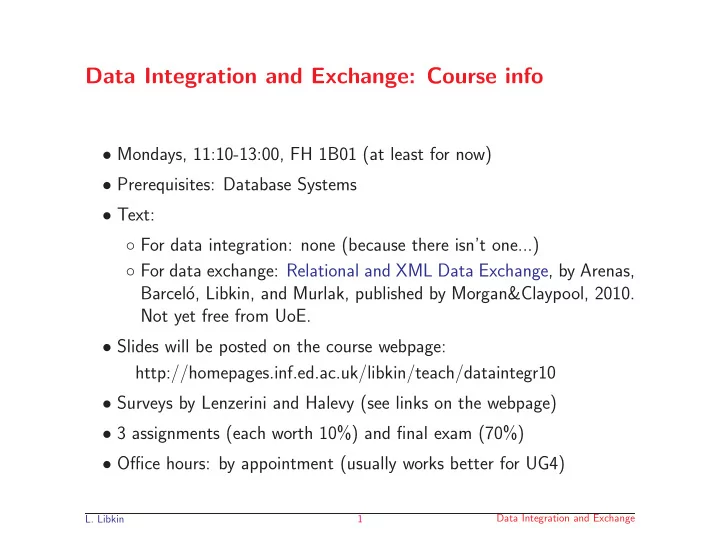

Data Integration and Exchange: Course info • Mondays, 11:10-13:00, FH 1B01 (at least for now) • Prerequisites: Database Systems • Text: ◦ For data integration: none (because there isn’t one...) ◦ For data exchange: Relational and XML Data Exchange, by Arenas, Barcel´ o, Libkin, and Murlak, published by Morgan&Claypool, 2010. Not yet free from UoE. • Slides will be posted on the course webpage: http://homepages.inf.ed.ac.uk/libkin/teach/dataintegr10 • Surveys by Lenzerini and Halevy (see links on the webpage) • 3 assignments (each worth 10%) and final exam (70%) • Office hours: by appointment (usually works better for UG4) Data Integration and Exchange L. Libkin 1
Why do you need this course • Databases are everywhere these days ( > $2 · 10 10 / year business — whatever that means today) • Every enterprise has a database; they merge, combine data – hence data integration • In addition, a lot of data is available on the web, but often one needs many sources to answer a query • Hence (almost) everyone needs to integrate data • Huge investment from leading companies, IBM, Oracle, Microsoft • Very ad hoc solutions; but finally we understand what the real problems in data integration are, and have some solutions (but not all!) Data Integration and Exchange L. Libkin 2
Data Integration and Exchange • Traditional approach to databases: ◦ A single large repository of data. – perhaps distributed across several sites ◦ Database administrator in charge of access to data. ◦ Users interact with the database through application programs. ◦ Programmers write those (embedded SQL, etc) ◦ Queries dominate; updates less common. ◦ DMBS takes care of lots of things for you • But the world is changing. Data Integration and Exchange L. Libkin 3
What happens these days • Many huge repositories are publicly available • Many queries cannot be answered using a single source. • Often data from various sources needs to be combined, e.g. ◦ company mergers ◦ restructuring databases within a single organisation ◦ combining data from several private and public sources • Different sources have different structures/models • Only portions of the data from some database could be available. • Our view of the world may be very different from the view of the databases we need to use Data Integration and Exchange L. Libkin 4
Integration and Exchange • Integration: answer queries using multiple sources: ◦ virtual approach, or ◦ materialization • Exchange: transfer data between two legacy database schemas • What changes: ◦ no clear notion of an answer to a query ◦ data is not clean: incomplete, inconsistent ◦ data may not even exist (virtual integration) • Our goal: study the main concepts and techniques for creating and querying integrated/exchanged data Data Integration and Exchange L. Libkin 5
Main topics • data integration basics ◦ scenarios, overview of products, techniques • integration and views • incomplete information • relational data exchange • overview of commercial tools • XML data exchange • schema mappings • inconsistent databases • top-k queries Data Integration and Exchange L. Libkin 6
Recommend
More recommend